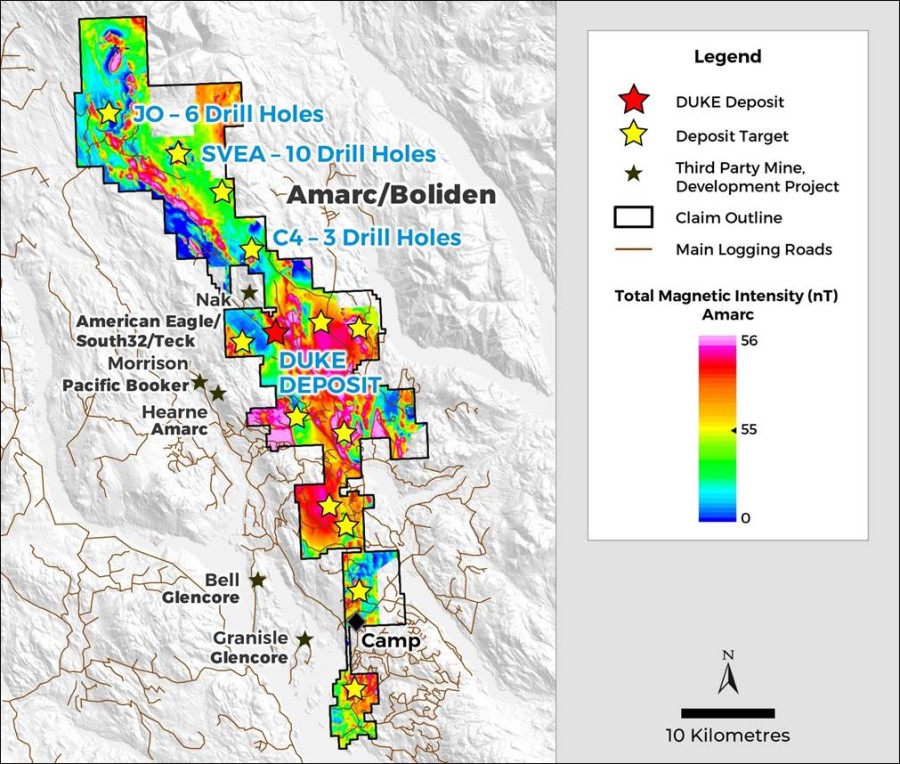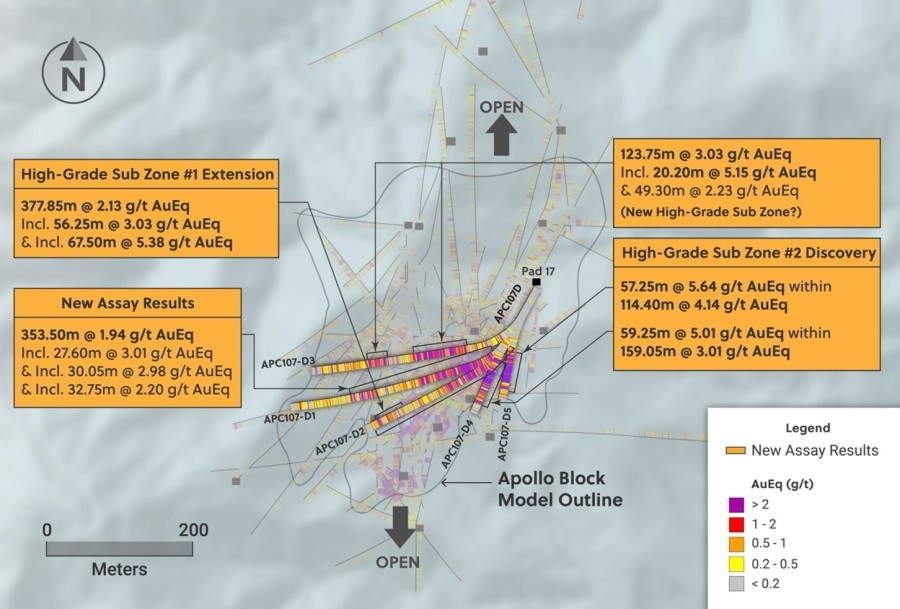VANCOUVER, BC / ACCESSWIRE / October 30, 2017 / CopperBank Resources Corp. ("CopperBank" or the "Company") (CSE: CBK) (OTC PINK: CPPKF) is pleased to report results from the fifth and sixth holes from its thirteen diamond drill hole (DDH) summer 2017 program on its 100% controlled Pyramid Copper Project in Alaska.
Highlights include:
- DDH 17PY035 intersected a total of 251 meters at a weighted average grade of 0.41% copper over two intervals; a near surface intercept of 137 meters of 0.45% copper (0.60% CuEq), and a second interval of 114 meters of 0.37 % copper (0.45% CuEq).
- DDH 17PY036 intersected 179.5 meters of 0.37% copper (0.52 % CuEq), confirming the continuity and width of the North Zone.
- As previously observed, no deleterious chemical elements such as arsenic, antimony, or selenium are present in significant levels.
The 2017 drilling program, comprising 3,690 meters in thirteen diamond drill holes, was designed to verify the extensions of known mineralization within the deposit and to validate the existing block model established by the historical resource estimate (SRK, June 2013). Detailed maps and cross sections can be found here. Previous diamond drill holes were reported in press releases dated October 5 and 23, 2017.
CopperBank Executive Chairman, Gianni Kovacevic, commented, "We're very pleased with the ongoing drilling success at Pyramid, as we continue to intersect broad intervals of copper mineralization. Importantly, numerous high-grade intercepts received to date from the 2017 program fall outside of the historical resource envelope, which should help further our goal of expanding upon the historic resource estimate at Pyramid. Six holes have now been reported, representing phase one of our 2017 drilling program, and we look forward to reporting the results of our final seven holes that test open areas in the Central and West Zones in due course."
Drill Hole 17PY035:
Located in the Main Zone, DDH 17PY035 was drilled to a depth of 349.9 meters and confirmed the existence of significant copper mineralization associated with the main quartz diorite porphyry intrusion as reported in DDH 11PY016 located 108 meters to the West. Two significant intervals of mineralization were intersected, separated by a 26 meter fault zone of clay altered quartz diorite porphyry. Mineralization is dominantly chalcopyrite with chalcocite, disseminated throughout the stratigraphic sequence. Detailed results are included in the table below. The results from 17PY035 and previously reported drill holes confirm a minimum length of 800 meters for the Main Zone. Significant amounts of high grade mineralization intersected to date in 2017 falls outside the envelope of the historical resource model.
|
From (m) |
To (m) |
Width (m) |
Cu (%) |
Mo (%) |
Au (g/t) |
CuEq (%) |
|
42 |
179 |
137 |
0.45 |
0.02 |
0.15 |
0.60 |
|
205 |
319 |
114 |
0..37 |
0.01 |
0.08 |
0.45 |
Note: The copper equivalent (CuEq) values in all tables in this press release were calculated based on estimated prices of US$2.75/lb of copper, US$1200/oz of gold and US$7.25/lb of molybdenum. No metallurgical tests were done. Metal recovery is unknown and was not taken into account. True width of intervals is yet to be defined.
Drill Hole 17PY036:
Located in the North Zone between historical holes DDH 11PY004 and 10PY001, DDH 17PY036 was drilled to a depth of 250.85 meters. Hornfels intruded by several porphyry dykes hosts chalcopyrite and chalcocite disseminations and composes the mineralized interval. The weighted average grade of the interval returns 0.37% Cu over 179.5 meters. The drill hole bottomed in a quartz biotite magnetic diorite.
|
From (m) |
To (m) |
Width (m) |
Cu (%) |
Mo (%) |
Au (g/t) |
CuEq (%) |
|
22.5 |
202 |
179.5 |
0.37 |
0.03 |
0.12 |
0.52 |
|
including |
||||||
|
35 |
51 |
16 |
0.50 |
0.06 |
0.14 |
0.73 |
Quality Control:
All core samples collected during the 2017 drilling program are pulverized at the ALS Fairbanks facilities then pulps are sent to ALS Minerals Laboratories in Reno, NV. All pulps are analyzed by a 4 acid multi-element analysis for 61 elements by ICP-AES method and assayed for Au by standard atomic absorption spectrometry (Au-AA23) following the fusion by fire-assay of a 30 gram sample. Samples returning copper values higher than 1% are re-analyzed in Vancouver by ICP-AES following a four-acid digestion and those exceeding 1 g/t gold by gravimetric finish (Au-GRA21). Standards, blanks and duplicates were inserted every 20 samples consistent with industry best practices then revised by a qualified person using a Quality Assurance/Quality Control program before calculating the intervals. A series of samples from hole 17PY-035 were sent back for verification following the detection of a possible contamination. The new analyses were used for the calculation of the mineralized intervals reported in this release.
About Pyramid:
The Pyramid project is located on private property with the subsurface controlled by The Aleut Corporation, an Alaska Native-owned corporation. Pyramid is a porphyry copper deposit containing a historical inferred mineral resource estimate of 122 million tonnes at 0.41% copper, 0.02% molybdenum, and 0.10 g/t gold (SRK, 2013) applying a 0.4% copper equivalent cut-off, divided into three main recognized zones: Main, North and West. The mineralization is related to a multi-phased calk-alkaline intrusion, intruding sediments of Tertiary Age. The porphyry system is of a minimal extent of 1.5 square kilometres, displays a leached cap, phyllic, propyllitic and potassic alteration analogous to the other copper deposits of the circum-Pacific Belt. The observed mineralization consists mainly in disseminations of chalcocite, chalcopyrite and local molybdenite and sulphide veinlets. Bornite, malachite and chrysocolla are also reported as accessory minerals.
This press release was prepared by Brigitte Dejou, P.Eng and a Qualified Person as defined by NI 43-101.





